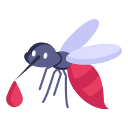WHAT IS A MOSQUITOES?
Mosquitoes are insects belonging to the order Diptera, commonly known as the True Flies. Here are some fascinating facts about these tiny but impactful creatures:

Anatomy & Behaviour
Both male and female mosquitoes feed on nectar or plant juices. However, females of most species require a blood meal to produce fertile eggs.
They are most active at night, dusk, and dawn—though some may bite during the day if disturbed.
Mosquitoes are notorious disease vectors, capable of spreading several serious illnesses such as:







Both male and female mosquitoes feed on nectar or plant juices. However, females of most species require a blood meal to produce fertile eggs.
They are most active at night, dusk, and dawn—though some may bite during the day if disturbed.
Mosquitoes are notorious disease vectors, capable of spreading several serious illnesses such as:

Species Diversity
There are over 3,000 mosquito species globally. Among the most common are:
Aedes species
Anopheles species
Culex species
Adult mosquitoes are usually less than 16 mm long, with scaled bodies and legs. Their colors range from gray to dark shades, sometimes with distinct markings in white, silver, brown, green, or even blue.
Males are easily identified by their feathery antennae and lack the piercing mouthparts that females use to feed on blood.
Life Cycle
Mosquitoes undergo complete metamorphosis with four distinct stages: egg, larva, pupa, and adult.
In tropical environments, the full cycle takes about 40–42 days.
Male mosquitoes typically live up to one week.
Female mosquitoes can live for 1–2 months.
Mating usually occurs just days after reaching adulthood. Males gather in swarms at dusk, where females enter to mate.
Different mosquito species lay eggs in various ways:
Anopheles lays single eggs directly on water surfaces.
Culex lays eggs in clusters or “rafts.”
Aedes lays eggs in semi-dry areas that hatch when water levels ris

Breeding Sites
Mosquitoes can adapt to a wide variety of water-based breeding sites, including:
Ponds and marshes
Drainage ditches
Tree holes
Buckets, tires, and other artificial containers
They avoid fast-moving or large open bodies of water. Their flight range varies based on species and environmental conditions such as temperature, wind, and humidity.
Mosquito Control Matters
Controlling mosquito populations starts with prevention. Regular inspection and elimination of stagnant water sources is key.
Simple actions like emptying unused containers, covering water tanks, and clearing clogged drains can go a long way in reducing mosquito breeding and protecting your health.

Home » Mosquitoes
Mosquitoes are insects belonging to the order Diptera, commonly known as the True Flies. Here are some fascinating facts about these tiny but impactful creatures:
Anatomy and Behavior:
Both male and female mosquitoes feed on nectar or plant juice. However, females of most species require a blood meal to lay fertile eggs. They usually bite at night, dusk, and dawn. Some mosquitoes may also bite during the day if disturbed.
Mosquitoes serve as vectors for several important diseases, including dengue fever, malaria, chikungunya, filariasis, encephalitis, zika and yellow fever. These diseases are transmitted to the host during feeding through saliva or contact.
Global warming is predicted to increase mosquito numbers and dispersion. Efforts should focus on removing or treating stagnant water sources where they breed.
Species Diversity: There are over 3,000 different species of mosquitoes worldwide.
Common species include:
a) Aedes sp.
b) Anopheles sp.
c) Culex sp.
Adult mosquitoes are usually no longer than 16 mm and have bodies and legs covered with scales. Their body colors range from gray to dark, with some marked by white, silver, brown, green, or even blue scales.
Males can be recognized by their feathery antennae and mouthparts not suitable for piercing.
Life Cycle:
Mosquitoes undergo complete metamorphosis (egg, larva, pupa, and adult) in their life cycle. This development process takes about 40-42 days in tropical conditions.
Adult males live up to a week, while female mosquitoes have a lifespan of about 1-2 months.
Mating usually occurs within a few days after becoming adults. Males form large swarms at dusk, where females fly in to mate.
Mosquitoes lay eggs in various ways:
a) Anopheles sp. lays eggs singly on water.
b) Culex sp. lays hundreds of eggs in raft shapes.
c) Aedes sp. oviposits in semi-dry places, where eggs can lie dormant until inundated by rising water.
Breeding Sites:
Mosquitoes adapt to various aquatic environments, including ponds, drainage ditches, tree holes, and artificial containers. They avoid open or large constant water flowing areas. Their flight range depends on factors like species, temperature, wind currents, and direction.
Effective control measures involve regular inspections and targeted removal or treatment of breeding sites. Let’s keep those pesky mosquitoes in check!

Don’t let termites ruin your home or business. Call us today to schedule an inspection and get a personalised treatment plan. With our help, your property stays safe and termite-free.
KLANG VALLEY (HQ)
Cheras
1 700 81 7529
NEGERI SEMBILAN
Seremban
+606 763 3929
MELAKA
Batu Berendam
+606 317 5939
JOHOR
Johor Bahru
+607 244 8558
PERAK
Ipoh
1 700 82 0529
PENANG &KEDAH
Perai / Alor Setar
+604 240 2037
© 2025 Skill Termite. All Rights Reserved.
Our team of experts is ready to help you eliminate pests quickly and safely. Get your free quote now!